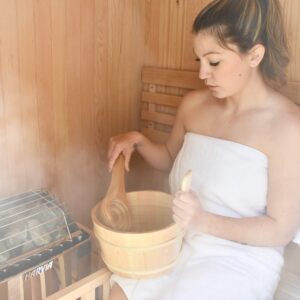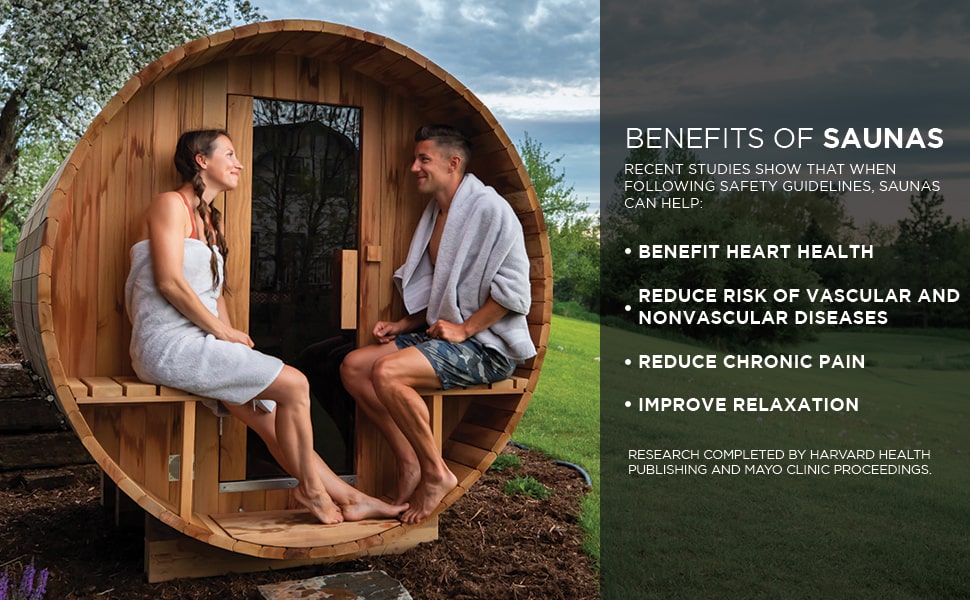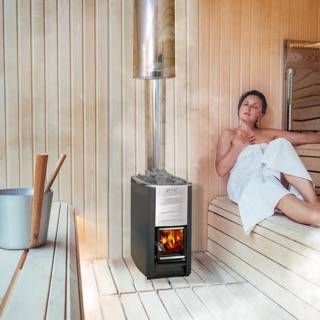Linked to everything from clearer skin to reduced muscle tension, the traditional sauna, with all of its sauna benefits, has become an increasingly attractive part of wellness routines and key home additions. But if you’re just beginning to discover the wonders of thermotherapy or heat therapy, you might wonder which kind of sauna is right for you.
So, what are some sauna health benefits, exactly, and how do wet vs dry saunas compare? Let’s get our feet wet (or not) and examine how each sauna type can help you create a wellness-boosting, at-home spa experience.
What is a Dry Sauna?
A dry sauna is an enclosed chamber that’s usually made of wood, typically cedar. The average sauna temperature is between 68 and 158 degrees—but can go up to 195 degrees, depending on the model, user, and venue (such as the gym or your favorite spa). Generally, the humidity in dry saunas hovers between 10 and 20%.
Originally designed in Finland, the heat in a traditional Finnish sauna, unlike steam rooms, is generated with either fuel, wood, or electrical power. Some dry saunas use an electric stove that warms a pile of hot rocks, producing heat throughout the chamber. Others use tempered glass to generate heat. Others still rely on an outdoor barrel chamber warmed with a wood-burning stove.
Dry saunas, like their wet counterparts, usually contain benches or another form of seating to allow you to soak in the heat—and pour out sweat, which is where the potential health benefits come in. The high temperature in dry saunas is similar to the aridness you would find in an inland location like the desert, as opposed to the sultry humidity you would experience in, say, Florida or Hawaii.

What is a Wet Sauna?

A wet sauna, or “Turkish-style” sauna, is similar to the traditional dry sauna in concept, style, and function, with one obvious difference—the involvement of water.
In a wet sauna, water is poured onto a stone set-up to produce steam, or features a steam generator that boils water for the same purpose. The heated rocks help elevate the sauna’s humidity level and, like a dry sauna, trigger sweat.
The heat in a wet sauna is typically kept at around 110 degrees. This can be substantially “cooler” than a dry sauna, but the high humidity makes the heat just as profound.
Dry Sauna vs Wet Sauna: Which is Better?
The answer to this is wholly subjective—and it depends completely on who you ask. Some sauna users appreciate the more uniform heat that’s found in dry saunas. Others are fonder of the humidity wet saunas possess.
Normally, dry saunas are hotter—but the high humidity in wet saunas is also deeply and immediately felt. If you’re considering procuring a sauna, keep in mind that hybrid models allow you to use dry heat and steam.
Regardless of the type of sauna you use, both can offer various potential health benefits.
What Are the Benefits of Dry and Wet Saunas?

Whether you choose a wet sauna or a hot sauna (or a hybrid model), the impact it can have on your body is believed to be the same. Sauna bathing may:
- Support cardiovascular health – Research demonstrates that high heat exposure may support heart health by amplifying vasodilation or the expansion of your blood vessels. This may improve body temperature regulation, blood circulation and blood flow throughout your body and have positive effects on your blood pressure.
- Enhance lung function – A 2018 review of medical studies published in Mayo Clinic Proceedings demonstrated that sauna bathing may boost respiration. Only a small number of studies have been conducted on this association, however, and more research needs to be performed before this finding is deemed conclusive.
- Ease tension and aches – Whether you have a condition like rheumatoid arthritis or aches and pains from a vigorous workout, sauna bathing — as a form of heat therapy — may soothe muscles, reduce joint stiffness, curb fatigue, and mitigate tenderness.
Sauna bathing is also used for:
- Relaxation and stress release
- Better sleep
- Athletic performance
- Workout recovery
- Detoxification
- Skin health and rejuvenation
- Congestion relief
- Immune function
- Blood circulation
- Emotional well-being
- Cognitive function, including improved memory and protection against neurodegenerative diseases
That said, there is some evidence that the humidity of a wet sauna may offer some additional benefits. Research shows that spending time in a steam room or wet sauna may help to lower your blood pressure. This is thought to be due to a hormone your body releases, called aldosterone, that helps to regulate your blood pressure. Another study found that moist heat, like that of a sauna, may help to improve circulation throughout your body.
Common Questions About Dry and Wet Saunas
Now you know the wet sauna vs dry sauna benefits—but you might still be curious about sauna use in general. A number of questions often pop up when it comes to saunas, both wet and dry. Here are several of the most frequently asked, along with our best answers:
When Should I Use a Sauna?
The beauty of sauna bathing is that it can be used at a variety of times.
Some sauna users “bathe” in the morning to bolster their energy for the day. Others use a sauna at night to feel its stress-relieving effects—both mentally and physically—which sets them up for a solid night’s sleep.
One of the most popular times to use a sauna, though, is after a workout. It’ll give you a moment to unwind and encourage your muscles to relax after they’ve been taxed.
Where Should I Put a Sauna in My Home?
The benefits of having an on-demand sauna experience are legion, allowing you to make sauna bathing a regular habit and giving you the option to use it at any time of day (and privately, to boot). Think of your sessions as relaxing, sauna therapy.
If you’re toying with the idea of purchasing an indoor sauna for your home, where to put the sauna in your house depends, of course, on where you have available interior space. You should also keep in mind whether the space you have available can provide the following:
- Ventilation
- Power
- Waterproof flooring
- Proximity to a shower
Many people elect to have their saunas installed in their master bathrooms, others in their garages. Others still use spare bedrooms. Regardless of where you place your unit, you’ll want to make sure you know how to clean a sauna so that each session is as sanitary as the previous one.
If you go with an outdoor model–such as one of ALEKO’S luxury outdoor saunas—your options naturally expand. You can place your outdoor sauna next to your pool or tuck it away in your backyard.
Wherever you choose to install a sauna, you’re bound to reap its rewards. It might also increase the value of your home.
How Long Should I Use a Sauna?
If you’re thinking about when to use a sauna and how long you should use it, you’ll want to consider a few factors. First, the duration of your sauna session largely depends on your comfort level. If you’re new to sauna bathing, consider starting out at five minutes and building up your time from there. However, you should limit your time to 15 minutes. If you extend it beyond this, be sure to take breaks to cool down—and hydrate. And if you feel dizzy, parched, or short of breath, exit the sauna and recoup.
If you have been drinking alcohol, eschew using a sauna. Likewise, dodge alcohol after sauna bathing to avoid exacerbating dehydration and fluid loss.
How Often Should I Use a Sauna?
Some experts suggest sauna bathing two to three times per week. Others recommend daily use to experience its benefits. Again, this will be up to you.
Will Using a Sauna Help Me Lose Weight?
More research is needed to determine whether spending time in a sauna may lead to weight loss. However, experts point out that what weight you may lose in a sauna is water weight due to sweating.
The heat in saunas can, however, cause your heart to beat faster, which may cause you to burn more calories than if you were in a non-heated environment. In addition, saunas can be a superb addition to a fitness-boosting workout program, potentially helping you to recover faster and get back in the game sooner.
Are Saunas Safe for Use?
Sauna bathing is generally considered safe, but the high temps present risks for people with certain conditions:
- Aortic stenosis
- Kidney disease
- Cardiovascular problems, such as a recent heart attack, high blood pressure, and unstable angina (or chest pain)
Pregnant women and young children should also avoid saunas. If you’re not sure whether your health condition might not mesh well with sauna use, it’s never a bad idea to talk with your doctor first.

Elevate Your Self-Care Routine with ALEKO
Finding ways to boost your wellness at home can be a life-changing process. With self-care tools at your disposal—such as a wet or dry sauna—you can achieve that blissful spa day feeling every day.
ALEKO combines masterful craftsmanship and meticulous construction to give you the ultimate sauna experience.
We have various home saunas for sale. With options ranging from cedar wet and dry saunas and barrel saunas to traditional models, you’re bound to find a sauna that suits your home, space, health goals, and lifestyle. We also offer a wide selection of sauna heaters and sauna accessories to uplevel your at-home spa experience, including wall-mounted thermometers, pine wood shower buckets, analog sauna clocks, seats, and benches.
Check out our products today and start seeing the vast advantages of prioritizing your well-being.
Sources:
Bustle. What does the sauna do for you? Its benefits, explained.
https://www.bustle.com/wellness/what-does-the-sauna-do-for-you
Healthline. Sauna after workout: what are the benefits?
https://www.healthline.com/health/fitness/sauna-after-workout#Health-benefits
Mayo Clinic Proceedings. Cardiovascular and other health benefits of sauna bathing: a review of the evidence.
https://www.mayoclinicproceedings.org/article/S0025-6196%2818%2930275-1/fulltext
Healthline. How to use a sauna.
https://www.healthline.com/health/how-to-use-a-sauna
Harvard Health. Sauna health benefits: are saunas healthy or harmful?
https://www.health.harvard.edu/staying-healthy/saunas-and-your-health
Forbes. The benefits of adding an in-home sauna.
NHS. Is it safe to use a sauna or jacuzzi if I’m pregnant?
Oxford Academic. Sauna bathing is inversely associated with dementia and Alzheimer’s disease in middle-aged Finnish men.
https://academic.oup.com/ageing/article/46/2/245/2654230
PubMed. [Effect of steam bath on gastric secretion and some endocrine changes of athlete-fighters]. https://pubmed.ncbi.nlm.nih.gov/21542324/
Medical Science Monitor. A comparison of whole body vibration and moist heat on lower extremity skin temperature and skin blood flow in healthy older individuals.






